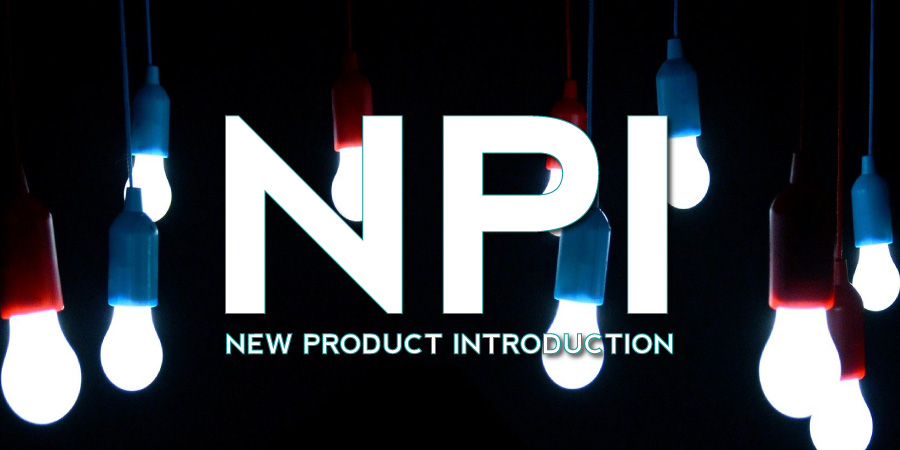While aiming to stay relevant and competitive in the market, companies must consistently convert new ideas into tangible products that satisfy their customers’ needs.
Introducing a new product or service begins with researching your customers to learn challenges before brainstorming useful product ideas that can adequately meet their needs. You’ll then vet the concepts carefully to determine the most appropriate introduction path to follow.
NPI (New Product Introduction) is a process of transforming product ideas from their initial working prototypes to thoroughly refined final products that are reproducible. The process requires substantial resources and time investment; hence you must carefully plan each introduction step for your results to be worth the investment and effort.
What Does New Product Introduction (NPI) Entail?
An introduction program comprises every organizational activity focused on defining, developing, and launching new or improved products. The final product may be tangible, like a new smartphone model, or intangible, like a particular service that never existed before. It’s common for entrepreneurs to use the acronyms NPD (New Product Development) and NPI interchangeably.
Organizations use different introduction strategies for new items, depending on their new product, goals, budget, and numerous other internal factors. Occasionally, there might be a distinction in the introduction of new solutions within different sections of the same entity.
Despite the differences, one factor stands out: Your new product introduction process’ success requires the company’s top management’s full active support across departments. It also requires substantial cross-functional teamwork and communication.
Reasons to Implement an NPI Strategy in Your Organization
Most savvy entrepreneurs understand how vital it is to have an efficient introduction process for new solutions. In the current market characterized by cut-throat competition, you must always come up with the right solutions at the correct cost and the right time. Creating a robust NPI process and aligning your operations with this strategy could mean the difference between triumph and disappointment with your new product.
The primary reasons why you need a robust NPI process include:
- Enhanced manufacturing efficiency – If you effectively implement the appropriate design for new product manufacturing and assembly best practices, your products will always be designed efficiently and with this approach in mind.
- Lower development costs – NPI approaches like VOC (voice of customer) can help avoid late changes to the new item’s design, multiple tweaking, and continuous expensive validation tests if implemented in your introduction project’s early stages.
- Shorter time to the marketplace – Product manufacturing efficiency and reduced new product development period mean that your product will take a shorter time to reach the right consumers and start generating revenue.
- Enhanced product/service quality – NPI strategies incorporate tools focused on ensuring the new item or service addresses all client needs. The introduction process must be able to maintain consistent new product quality.
Crucial Elements of the NPI Process
An effective and efficient introduction strategy must allow you to deliver excellent new products at the required time and a favorable budget. Here are some of the primary NPI elements:
1- Current State Evaluation
To generate a new item that satisfies your customers’ needs, you must first ascertain their problems and needs before the introduction. To learn this, you must conduct a detailed current state analysis, which helps you identify your current state’s key strengths and weak points that should be improved. This way, you’ll ensure that you’re developing a product or service that can accurately address the market’s problems.
2- Clearly Defined Responsibilities and Roles
Almost every organizational setup requires clearly defined responsibilities and goals to achieve better company collaboration and enhanced communication. By defining these roles in advance, you’ll reduce the costs and risks of rework and duplicate effort while exploring the opportunities for improved problem solving and decision making.
3- Cost, Quality, and Delivery Goals
One of the primary targets of new item introduction is improving the company’s ability to offer excellent services and quality products at the right time and budget. As such, it makes sense to include cost, quality, and delivery objectives as the vital components of your NPI strategy.
4- Scalability in Implementation
The ultimate goal of all NPI strategies involves optimizing the introduction of new products and services throughout the organization. As such, scalability can be an excellent indicator of your NPI approach’s efficiency.
5- Standardized Support Structure
When managing a large organization’s NPI, developing standardized tools and templates to document the entire introduction process will encourage knowledge sharing and alignment. By effectively sharing knowledge, the company can keep progress as it grows, facilitating creative problem solving and improved innovation.
Overview of the NPI Process
As mentioned, companies leverage different NPI approaches, and there’s no stated procedure to achieve the best results. However, these standard introduction practices will help you come up with products that address your clients’ problems:
- Defining – This is the first stage, and it involves specifying the service or product’s performance and functionality.
- Feasibility – Here, the company’s top management will evaluate the planned product’s success potential. This may involve reviewing the design concepts to ascertain whether they meet the requirements in the previous stage.
- Development – Here, your service or product’s design features will be clearly defined. This process involves risk assessment and evaluation of the production process.
- Validation – This stage involves conducting tests on product prototypes and the execution of the appropriate design changes.
- Implementation – Here, you’ll refine and validate your manufacturing process through capacity studies and pilot builds. You’ll also establish and implement quality and documentation controls.
- Evaluation – At this last phase, you’ll gather client feedback on the newly released service product.
An NPI strategy helps streamline the way you manage tons of moving segments simultaneously. Through this approach, you’ll ensure your team communicates effectively to ensure a smooth introduction process from design and prototyping to product engineering and manufacturing. What’s more, you’ll easily manage your product concept, overseeing every step from design to the first manufacturing run.





